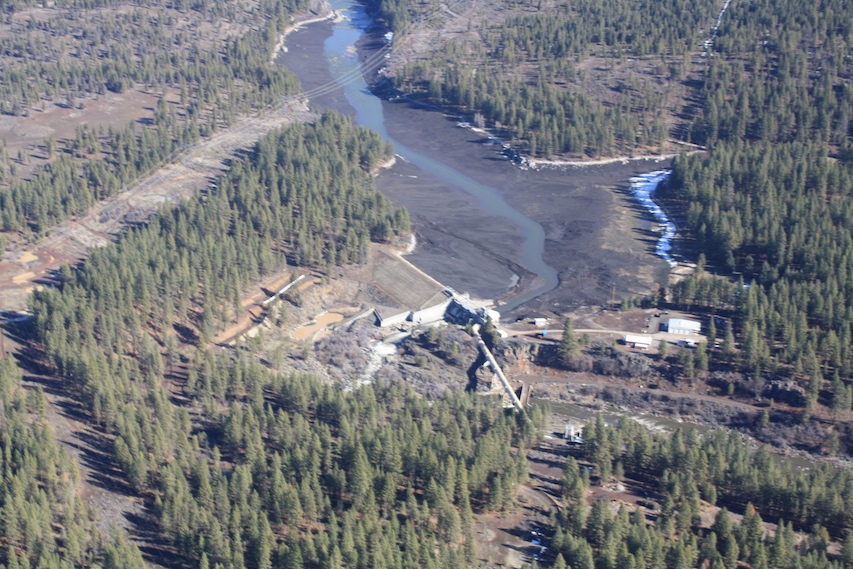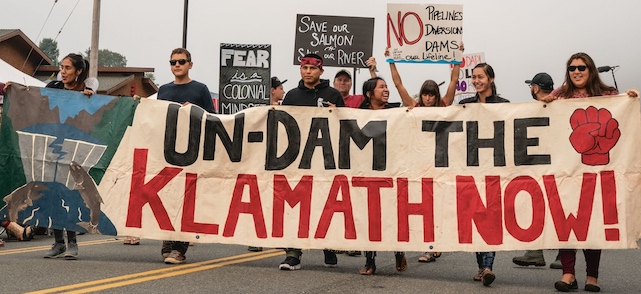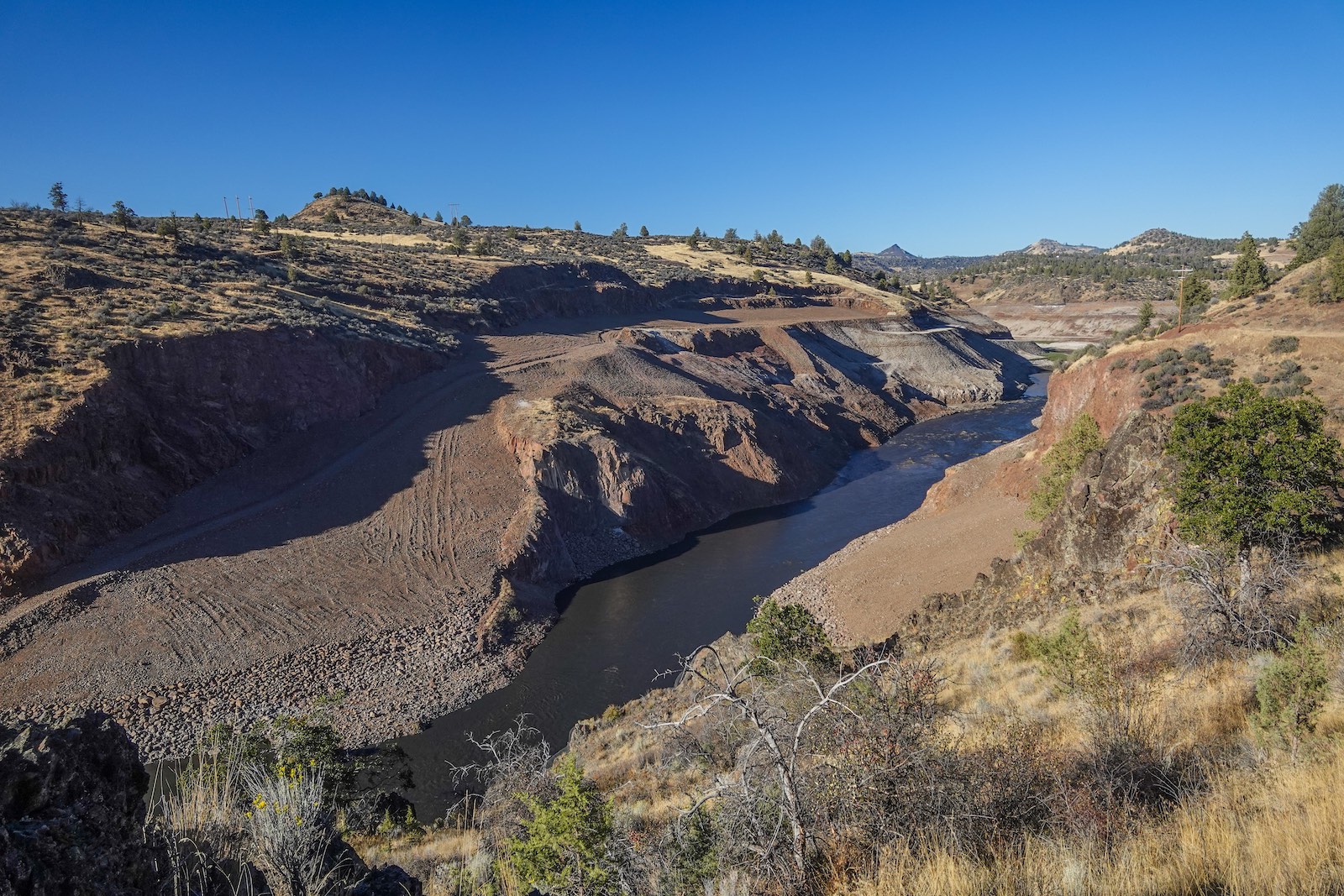

West |
Central |
East |
All Four Lower Klamath River Dams Removed
All four lower Klamath River hydropower dams have been removed. Kiewit, the dam removal contractor hired by the Klamath River Renewal Corporation to complete the construction elements of the project, finished all work this month in the river.
Several Years of Work Ahead to Restore Formerly Submerged Lands
-- Columbia Basin Bulletin, October 8, 2024Following the cofferdam breaches last month, a portion of the Iron Gate cofferdam and a temporary river crossing at Copco No. 1 were left in place to provide access to the far side of the river in order to remove diversion infrastructure. With all the diversion infrastructure, temporary bridges, and dam materials now fully removed from the river, the dam removal portion of the Klamath River Renewal Project is now complete.
Together, Copco No. 1, Copco No. 2, J.C. Boyle, and Iron Gate Dams had blocked fish passage and impaired water quality for more than a century. All four were hydroelectric dams that did not provide irrigation or drinking water and were not operated for flood control.
Following decades of advocacy, led by area tribes and supported by conservation advocates, commercial fishing organizations, and the States of California and Oregon, federal regulators approved the removal of the dams in November 2022. Ownership of the project was then transferred to the Klamath River Renewal Corporation, the organization that was created to oversee the removal of the dams and related restoration of the previously submerged lands.
Copco No. 2, the smallest dam, was removed in the summer of 2023. In January of 2024 the Copco No. 1, JC Boyle, and Iron Gate reservoirs were drained, and deconstruction began in the spring. Massive amounts of concrete, earth, rocks and clay was removed from the river channel as part of the dam removal process.
With these obstructions now cleared from the mainstem river, fish once again have access to more than 400 stream miles, including in tributary creeks and streams, of habitat in the upper Klamath Basin.
While the dam removal portion of the project is now complete, work will continue for several years restoring the 2,200 acres of formerly submerged lands. As the reservoirs drained in January, native seed mix was applied to the reservoir footprints. This initial round of seeding was intended to stabilize sediments and improve soil composition.
This fall, restoration crews will turn their attention to amending soil conditions and will then perform another round of seeding and planting. Restoration crews will be onsite until vegetation success meets predetermined performance metrics. Restoration work is likely to continue for at least the next several years.
"These final dam removal steps set the stage for salmon to return to reclaimed habitat and expand their population recovery," said Jim Simondet, NOAA Fisheries West Coast Region Klamath Branch Supervisor.
NOAA Fisheries analyzed the impacts of dam removal on Endangered Species Act-listed species in a biological opinion. That analysis found that the short-term impacts, such as the potential effects of sediment in the water on salmon, would be outweighed by the much greater long-term benefits as river ecosystem processes return at a landscape scale.
Before the final removal steps, NOAA Fisheries convened a forum called the Fisheries Coordination Team to discuss how to best protect fish and water quality. It included experts from tribes, states, and other federal agencies. The team provided technical recommendations to manage water quality impacts, such as those observed earlier in the year when the reservoirs were initially drained. Crews used a strategy of releasing sediment and organic material that muddied the river but avoided a decline in dissolved oxygen that could have otherwise harmed fish.
"The network of water quality monitoring sites managed by the tribes are providing real-time data to the Fisheries Coordination Team, allowing them to manage sediment inputs and adaptively manage fisheries needs during the final removal process," said Toz Soto, Fisheries Program Manager for the Karuk Tribe.
The KRRC followed the recommendation to remove sediment and organic material from behind the cofferdam before the dam was fully removed. That resulted in a slower release of the material. The Fisheries Coordination Team will hold weekly check-ins to track extensive water quality monitoring up and down the river.
"Our goal was to provide a forum that allowed for transparent sharing of information, collection of observations, and recommendations from experts who live and work on the river," said Shari Witmore, a fisheries biologist in NOAA Fisheries West Coast Region's Klamath Branch. "Leaning on the advice of our partners, we were able to minimize impacts to fish in the Klamath River during the final step of dam removal."
"Given all the complexities and details necessary to remove the four dams, the work has gone pretty smoothly and commensurate with our expectations," Simondet said. "That is a testament to the hard work and expertise of the KRRC and its contractors and the planning we all contributed to ahead of time to get this right."
Restoration and recovery of the river will continue for the coming years.
